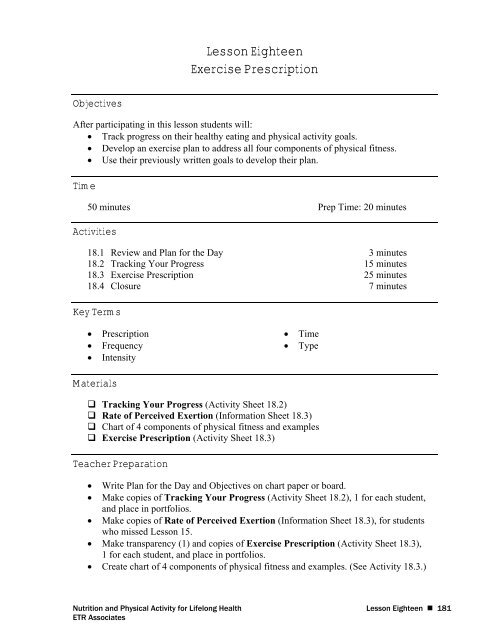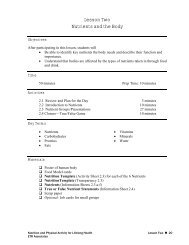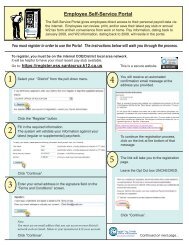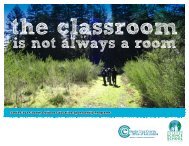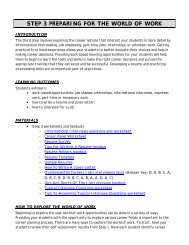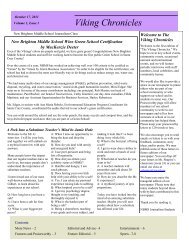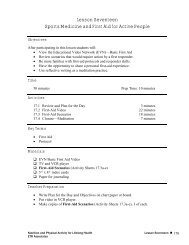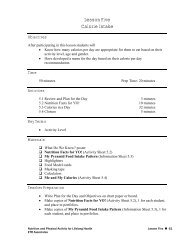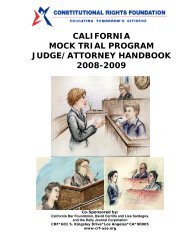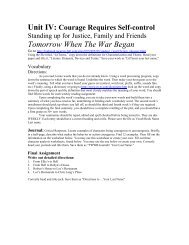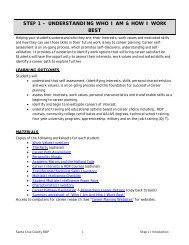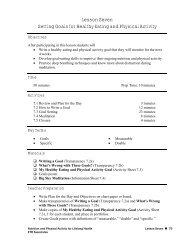Lesson 18 - Physical Education for Body, Mind and Spirit
Lesson 18 - Physical Education for Body, Mind and Spirit
Lesson 18 - Physical Education for Body, Mind and Spirit
You also want an ePaper? Increase the reach of your titles
YUMPU automatically turns print PDFs into web optimized ePapers that Google loves.
<strong>Lesson</strong> Eighteen<br />
Exercise Prescription<br />
Objectives<br />
After participating in this lesson students will:<br />
• Track progress on their healthy eating <strong>and</strong> physical activity goals.<br />
• Develop an exercise plan to address all four components of physical fitness.<br />
• Use their previously written goals to develop their plan.<br />
Time<br />
50 minutes Prep Time: 20 minutes<br />
Activities<br />
<strong>18</strong>.1 Review <strong>and</strong> Plan <strong>for</strong> the Day 3 minutes<br />
<strong>18</strong>.2 Tracking Your Progress 15 minutes<br />
<strong>18</strong>.3 Exercise Prescription 25 minutes<br />
<strong>18</strong>.4 Closure 7 minutes<br />
Key Terms<br />
• Prescription<br />
• Frequency<br />
• Intensity<br />
• Time<br />
• Type<br />
Materials<br />
Tracking Your Progress (Activity Sheet <strong>18</strong>.2)<br />
Rate of Perceived Exertion (In<strong>for</strong>mation Sheet <strong>18</strong>.3)<br />
Chart of 4 components of physical fitness <strong>and</strong> examples<br />
Exercise Prescription (Activity Sheet <strong>18</strong>.3)<br />
Teacher Preparation<br />
• Write Plan <strong>for</strong> the Day <strong>and</strong> Objectives on chart paper or board.<br />
• Make copies of Tracking Your Progress (Activity Sheet <strong>18</strong>.2), 1 <strong>for</strong> each student,<br />
<strong>and</strong> place in portfolios.<br />
• Make copies of Rate of Perceived Exertion (In<strong>for</strong>mation Sheet <strong>18</strong>.3), <strong>for</strong> students<br />
who missed <strong>Lesson</strong> 15.<br />
• Make transparency (1) <strong>and</strong> copies of Exercise Prescription (Activity Sheet <strong>18</strong>.3),<br />
1 <strong>for</strong> each student, <strong>and</strong> place in portfolios.<br />
• Create chart of 4 components of physical fitness <strong>and</strong> examples. (See Activity <strong>18</strong>.3.)<br />
Nutrition <strong>and</strong> <strong>Physical</strong> Activity <strong>for</strong> Lifelong Health <strong>Lesson</strong> Eighteen • <strong>18</strong>1<br />
ETR Associates
<strong>18</strong>.1 Review <strong>and</strong> Plan <strong>for</strong> the Day 3 minutes<br />
Materials: Plan <strong>for</strong> the Day <strong>and</strong> Objectives<br />
Write the Plan <strong>for</strong> the Day <strong>and</strong> Objectives on the board be<strong>for</strong>e class, listing all of the<br />
activities students will be doing.<br />
Plan <strong>for</strong> the Day:<br />
• Tracking Your Progress<br />
• Exercise Prescription<br />
• Closure<br />
Review the previous class. Let students know that they can take classes to become certified<br />
in CPR <strong>and</strong> First Aid.<br />
Explain that in today’s lesson they will be designing their own workout program based on the<br />
goals they created earlier in this class <strong>and</strong> on what they have learned about physical fitness.<br />
Review the Objectives with students.<br />
<strong>18</strong>.2 Tracking Your Progress 15 minutes<br />
Materials: Tracking My Progress (Activity Sheet <strong>18</strong>.2)<br />
Tell students that a week has passed since the last time they tracked progress on their goals.<br />
It is time again to see what they have achieved on their healthy eating <strong>and</strong> physical activity<br />
goals.<br />
• Refer students to the Tracking My Progress activity sheet in their portfolios. Have<br />
them write in their goals <strong>for</strong> both healthy eating <strong>and</strong> physical activity.<br />
• Then have them fill out the rest of the sheet keeping both of their goals in mind.<br />
• Ask a couple of students to share how they did on their goals this past week. What<br />
were the challenges? What did they do to meet their goals? How did they feel about<br />
working toward their goals?<br />
<strong>18</strong>.3 Exercise Prescription 25 minutes<br />
Materials: Rate of Perceived Exertion (In<strong>for</strong>mation Sheet <strong>18</strong>.3), chart of 4 components of<br />
physical fitness <strong>and</strong> examples, Exercise Prescription (Activity Sheet <strong>18</strong>.3)<br />
Explain that students are going to create an exercise prescription (a written direction <strong>for</strong> the<br />
administration of an exercise) <strong>and</strong> in order to do this they need to know the parts of the<br />
prescription.<br />
Nutrition <strong>and</strong> <strong>Physical</strong> Activity <strong>for</strong> Lifelong Health <strong>Lesson</strong> Eighteen • <strong>18</strong>2<br />
ETR Associates
• Write the letters F-I-T-T vertically on the dry erase/chalkboard or a piece of chart<br />
paper. Tell students that each of these letters st<strong>and</strong>s <strong>for</strong> one of the parts to their<br />
exercise prescription.<br />
• Start with F <strong>and</strong> write Frequency (how often you do the exercise). Tell students what<br />
frequency means. Explain that just as in writing their goals, they want to be specific<br />
when addressing frequency, <strong>for</strong> example, 3 times/week. Write the example on the<br />
board next to the definition. Explain that as teenagers they should try to exercise at a<br />
minimum of 3 times per week.<br />
• Next to the letter I, write the word Intensity. Survey the students about what this<br />
word means (how much of an ef<strong>for</strong>t put into the exercise). Write this definition on the<br />
board. Explain that intensity is measured by your heart rate <strong>for</strong> cardiorespiratory<br />
fitness. They will know what their heart rate should be <strong>for</strong> 50-85% of their maximum<br />
heart rate if they were in class <strong>for</strong> the cardiorespiratory lesson. Give an example of a<br />
target heart rate zone, such as 120 to 175 beats per minute. To increase<br />
cardiorespiratory fitness, they should work at an intensity range of 50-85% of their<br />
maximum heart rate.<br />
• If students missed the cardiorespiratory lesson give them a copy of the Rate of<br />
Perceived Exertion (RPE) in<strong>for</strong>mation sheet to use as a guide <strong>for</strong> finding intensity<br />
level. Explain how it is used. When they are exercising they can put a number on<br />
how hard they are working, with 0 being not at all <strong>and</strong> 10 being maximal amount of<br />
exertion. They can write a number on their exercise prescription <strong>for</strong> the intensity<br />
level to work toward when exercising.<br />
• T st<strong>and</strong>s <strong>for</strong> Time (the amount of time spent on a given activity in one session).<br />
Write the definition on the board. Explain to students that it is recommended that<br />
they spend between 20 <strong>and</strong> 30 minutes on an activity in a single session to gain the<br />
benefits of that activity, <strong>for</strong> example, 30 minutes of running at 50% of maximum<br />
heart rate.<br />
• The second T st<strong>and</strong>s <strong>for</strong> Type (what kind of physical activity are you participating<br />
in). Write the definition on the board <strong>and</strong> give some examples of different types of<br />
physical activity.<br />
Explain to the students that they will be taking these FITT principles <strong>and</strong> applying them to<br />
the 4 components of fitness. The end result will be an exercise prescription <strong>for</strong> them to use.<br />
• Direct students’ attention to the chart with the 4 components of physical fitness <strong>and</strong><br />
examples. Ask the students <strong>for</strong> examples of other activities they like to do under a<br />
particular component of physical fitness. Add those to the chart.<br />
Note: Create the chart be<strong>for</strong>e class using the following in<strong>for</strong>mation as an example:<br />
1. Cardiorespiratory Fitness: Tennis, basketball, soccer, running, swimming<br />
2. Muscular Endurance: Walking with a backpack, running, raking leaves<br />
3. Muscular Strength: Sit-ups, push-ups, sprinting, lifting weights<br />
4. Flexibility: yoga, stretching<br />
Nutrition <strong>and</strong> <strong>Physical</strong> Activity <strong>for</strong> Lifelong Health <strong>Lesson</strong> Eighteen • <strong>18</strong>3<br />
ETR Associates
• Show students the Exercise Prescription activity sheet in their portfolios. (It may be<br />
helpful to make an overhead transparency of this sheet to work along with students.)<br />
Explain that their prescription is specific to them. Give an example of a prescription<br />
a doctor might give (take 2 tablets 3 times per day <strong>for</strong> 6 weeks). This prescription<br />
would be different <strong>for</strong> different people. Tell them they can use the list of physical<br />
fitness examples to help them complete their exercise prescription.<br />
• Make the point that this is a beginning exercise plan, unless they have already been<br />
participating in an activity. For example, if they run <strong>for</strong> 30 minutes 3 times per week,<br />
they are already on an exercise plan <strong>and</strong> they can look at increasing the time,<br />
frequency or intensity. If they are just starting the exercise plan/prescription, they<br />
will want to wait 4 to 6 weeks be<strong>for</strong>e they increase the workload. Too much too fast<br />
leads to burn out!<br />
• After they have been on the prescription <strong>for</strong> 4 to 6 weeks, they will increase each of<br />
the FITT principles in increments, not all at the same time. For example, they may<br />
first increase the intensity from 50% to 65% of their maximum heart rate <strong>for</strong> 1 week,<br />
then depending on how their body feels they can increase the time or frequency the<br />
following week. The point is to gradually build up to their goal <strong>for</strong> physical fitness.<br />
Once they reach the goal, they can then create a new goal.<br />
• Make sure students consult their physical activity goal so that they can relate the plan<br />
to their stated goal as they create their exercise prescription. If they are unhappy with<br />
their goal, invite them to change it to something more appealing or pertinent.<br />
• Have students take out the Exercise Prescription activity sheet. Tell them to write<br />
their name where it says, “Exercise prescription <strong>for</strong>….” Direct their attention to the<br />
two boxes on the top of the worksheet labeled “Cardiorespiratory Fitness” <strong>and</strong><br />
“Muscular Strength <strong>and</strong> Endurance.”<br />
• Explain that they are going to be filling in these two boxes <strong>for</strong> their own use. Using<br />
the overhead transparency of the Exercise Prescription activity sheet, give an<br />
example of what they might write in the Cardiorespiratory box. Check in with<br />
students who are using the RPE scale to make sure they underst<strong>and</strong> what to write<br />
down <strong>for</strong> intensity.<br />
• Once students have completed the Cardiorespiratory box, go on to the Muscular<br />
Strength <strong>and</strong> Endurance box. Write an example <strong>for</strong> students to follow. Then walk<br />
around helping students where needed.<br />
• Read the section on Flexibility <strong>and</strong> have students write in some stretches that would<br />
address the muscles they would be using in their exercise session.<br />
• Direct students’ attention to the last paragraph <strong>and</strong> explain to them that an exercise<br />
session includes three parts: a warm-up, the training period (which is doing the<br />
activities listed in the boxes above) <strong>and</strong> cool-down activities.<br />
Nutrition <strong>and</strong> <strong>Physical</strong> Activity <strong>for</strong> Lifelong Health <strong>Lesson</strong> Eighteen • <strong>18</strong>4<br />
ETR Associates
• Have students use the space available to write a complete exercise session. Give an<br />
example on the overhead transparency if needed.<br />
• Walk around the room <strong>and</strong> check in with students to make sure they are filling out the<br />
activity sheet properly <strong>and</strong> to answer any questions they may have.<br />
<strong>18</strong>.4 Closure 7 minutes<br />
Materials: Exercise Prescription (Activity Sheet <strong>18</strong>.3)<br />
Have students do some self reflection. Ask them to look through their exercise prescription<br />
<strong>and</strong> determine if this is an accurate prescription <strong>for</strong> them to improve their physical condition.<br />
Then have them pass the prescription to someone else <strong>and</strong> have this person look at it <strong>for</strong><br />
accuracy.<br />
Have students share their prescriptions with the class <strong>and</strong> talk about how they can support<br />
each other to stay on track in the future.<br />
Nutrition <strong>and</strong> <strong>Physical</strong> Activity <strong>for</strong> Lifelong Health <strong>Lesson</strong> Eighteen • <strong>18</strong>5<br />
ETR Associates
Activity Sheet 15.5<br />
My healthy eating goal:<br />
My physical activity goal:<br />
Date: __________<br />
What I did to meet my goals:<br />
‣ _________________________________________________________<br />
‣ _________________________________________________________<br />
‣ _________________________________________________________<br />
‣ _________________________________________________________<br />
‣ _________________________________________________________<br />
What I learned this week:<br />
Benefits I enjoyed this week: _____________________________________________<br />
_____________________________________________________________________<br />
Challenges I had: ______________________________________________________<br />
____________________________________________________________________<br />
Possible ways to deal with challenges if they come up again: ____________________<br />
_____________________________________________________________________<br />
What am I going to do toward my goals next week: ____________________________<br />
____________________________________________________________________<br />
Who could help me with my goals if I need support: ___________________________<br />
Adapted with permission from Health Smart High School.<br />
Nutrition <strong>and</strong> <strong>Physical</strong> Activity <strong>for</strong> Lifelong Fitness <strong>Lesson</strong> Fifteen • <strong>18</strong>6<br />
ETR Associates
Rate of Perceived Exertion<br />
In<strong>for</strong>mation Sheet <strong>18</strong>.3<br />
0 – Nothing at all<br />
1 – Very light<br />
2 – Light<br />
3 – Somewhat moderate<br />
4 – Moderate<br />
5 – Somewhat hard<br />
6 – Hard<br />
7 – Somewhat intense<br />
8 – Intense<br />
9 – Almost maximal<br />
10 – Maximal<br />
Nutrition <strong>and</strong> <strong>Physical</strong> Activity <strong>for</strong> Lifelong Health <strong>Lesson</strong> Eighteen • <strong>18</strong>7<br />
ETR Associates
Exercise Prescription<br />
<strong>for</strong><br />
____________________<br />
Cardiorespiratory Fitness<br />
Frequency____________________<br />
Intensity<br />
Heart Rate _______<br />
RPE ____________<br />
Time_________________________<br />
Type_________________________<br />
Muscular Strength <strong>and</strong> Endurance<br />
Frequency ___________________________<br />
Intensity (resistance) _________________<br />
Time is determined by:<br />
Sets_________________<br />
Repetitions__________<br />
Type ________________________________<br />
Flexibility<br />
Depending on the type of activity you are per<strong>for</strong>ming, the muscles to be used should be<br />
stretched both be<strong>for</strong>e <strong>and</strong> after the activity. Pick some stretches you know to per<strong>for</strong>m<br />
during your exercise session. ___________________________________________<br />
*A stretch should be held <strong>for</strong> at least 20 seconds.*<br />
Every exercise session should include a warm up, training period<br />
<strong>and</strong> a cool-down. Use the line to write in a sample exercise session with a warm-up,<br />
training period <strong>and</strong> cool-down.<br />
‣ Warm-up can include stretching <strong>and</strong>/or a light cardiorespiratory activity.<br />
(For example; a slow jog or a brisk walk)<br />
______________________________________________________<br />
‣ Training period is the main piece of the workout, whether it’s<br />
cardiorespiratory or muscular strength/endurance.<br />
______________________________________________________<br />
‣ Cool-down should include some stretching of muscles used during<br />
training period or a light cardiorespiratory activity.<br />
______________________________________________________<br />
Nutrition <strong>and</strong> <strong>Physical</strong> Activity <strong>for</strong> Lifelong Health <strong>Lesson</strong> Eighteen • <strong>18</strong>8<br />
ETR Associates


